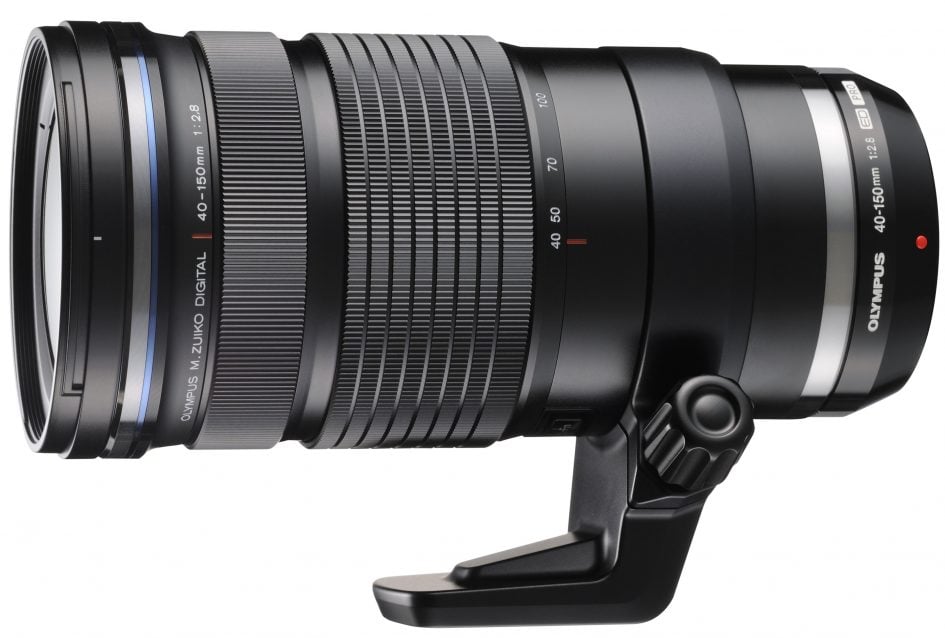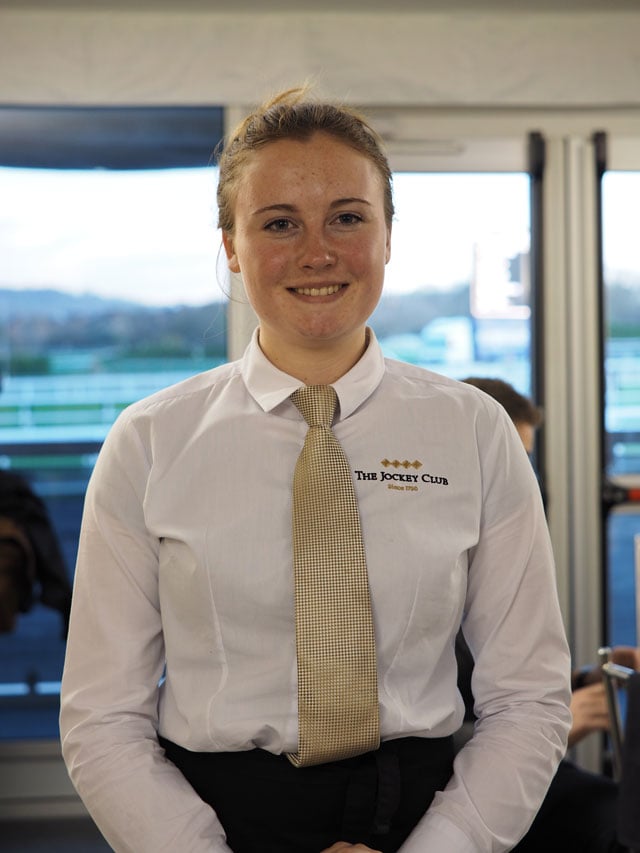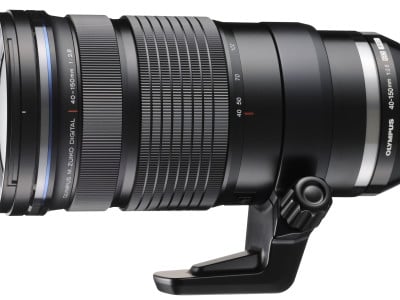Olympus 40-150mm f2.8 review
-
-
Written by Ken McMahon
Intro
The Olympus M.Zuiko Digital ED 40-150mm f2.8 Pro is a high-end telephoto zoom for the Micro Four Thirds system – as such it’ll work on any modern Panasonic or Olympus body. It was originally teased in September 2013 at the launch of the OMD EM1 and 12-40mm f2.8 Pro zoom, but took a whole year to finally come to market, officially being announced during Photokina in September 2014.
It’s fair to say this has been a highly anticipated lens, seamlessly continuing where the 12-40mm stops, and delivering an 80-300mm equivalent range that’s desired by close-range action as well as street and portrait shooters. Now with two lenses, Olympus can take you from an equivalent of 24mm all the way to 300mm with a constant f2.8 focal ratio throughout, and while the 40-150mm is obviously one of the larger lenses in the catalogue, it remains compact for a lens for its class. As well as superior optics and performance, the Pro tag denotes high quality construction with an all metal body that is dust, splash and freeze-proof. The lens also comes with a removable lens collar for tripod mounting, as well as a collapsible lens hood.
Following an initial day of testing at the Cheltenham horse races with Ken McMahon, Gordon sourced a second sample of the lens and tested it for a month in a wide variety of portrait, landscape and action environments. He also retested the lens with the Olympus ODM EM1 updated to firmware 2.2 which claims to deliver superior AF precision with the 40-150mm. Read on to find out if this is the telephoto zoom Micro Four Thirds owners have been waiting for.
Olympus 40-150mm f2.8 Pro design and build quality
The first thing that strikes you about the M.Zuiko 40-150mm f2.8 Pro is its compactness. It measures 79mm in diameter, is 160mm long and weighs 880g including its removable tripod collar. Take the collar off and the weight falls to 760g. I use f-stop backpacks and was impressed to find I could just about accommodate the 40-150mm standing up in one of the deep ICUs rather than lying it on its side.
Olympus likes to say how much smaller and lighter its lenses are than DSLR equivalents, and often cites comparisons with 70-200mm f2.8 options from Canon and Nikon. I think it’s important to qualify this further as there’s pros and cons on both sides. The 40-150mm f2.8 is indeed considerably smaller and lighter than a 70-200mm f2.8 designed for full-frame use – for example, Canon’s EF 70-200mm f2.8L USM IS II measures 89x199mm and weighs 1490g, making it double the weight and noticeably chunkier. The Olympus lens will also out-reach it with an equivalent field of view of 300mm. But as always it’s a double-edged sword and while having an f2.8 focal ratio on both lenses means they’ll share the same exposures, their relative depth-of-field is quite different, with the Olympus lens actually being equivalent to a 80-300mm f5.6 lens on a full-frame system. So a fairer comparison in terms of what you can actually achieve in terms of reach and depth-of-field may be something like Canon’s EF 70-300mm f4.5-5.6 which measures 89x143mm and weighs 1050g – shorter than the Olympus, but thicker and still around 50% heavier.
Within the Micro Four Thirds range, the closest rival is Panasonic’s 35-100mm f2.8 which measures 67mm in diameter 100mm in length and weighs 360g, significantly smaller and around half the weight of the Olympus. That difference is all the more remarkable when you consider the Panasonic lens is optically stabilised where the M.Zuiko 40-150mm relies on the built-in stabilisation of Olympus OMD and PEN bodies to iron-out any wobbles. That said, there is of course also a substantial difference in the respective zoom ranges of these two with the Panasonic lens’s ‘classic’ 70-200mm equivalent range starting slightly wider but stopping well short of the 80-300mm equivalent range of the Olympus lens.
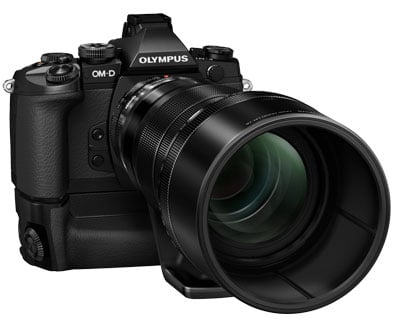 |
As I’ve mentioned, the 40-150mm f2.8 Pro has a zoom collar for tripod mounting. It can be adjusted to any position by loosening the locking screw with your fingers, rotating the collar, then re-tightening it. You can also remove the collar altogether, but although this lightens the load by 120 grams I wouldn’t recommend it. I found the tripod mount made an ideal handle for carrying the camera round even when shooting handheld.
When fitted to the OMD EM1, the camera and lens combination is beautifully balanced. It feels just right, not just when carrying it around but when you raise the camera to your eye and shift your left hand from the tripod mount to the zoom ring.
The 40-150mm f2.8 Pro is supplied with a lens hood which attaches to the front of the lens via the usual bayonet mount, but has a unique retracting design. Twist and push back and the hood retracts over the body of the lens reducing the overall length to the 160mm of the lens itself, very handy for stowing away in a bag or simply when you’re not shooting and much more convenient than a reversible hood. To extend the hood you simply pull it back out until it locks into place – a clever idea.
I’ve mentioned how well balanced the M.Zuiko 40-150mm f2.8 Pro feels when attached to the OMD EM1, the internal zoom mechanism means the the front of the lens doesn’t extend when you turn the zoom ring, maintaining the same overall length and balance. The front element doesn’t rotate when focusing so you can use a circular polarizer with ease. The lens has a 72mm filter thread.
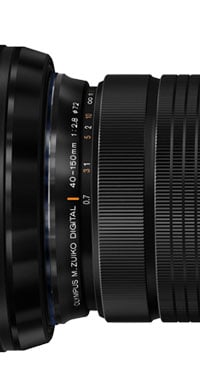 |
While it’s small and comparatively light the M.Zuiko 40-150mm f2.8 Pro nonetheless feels like a solid piece of optical engineering. The zoom and focus rings have a textured finish that provides a secure comfortable grip and the motion of the zoom ring is super-smooth with enough resistance to maintain the set focal length without creeping if the lens is pointed up or down.
As on the M.Zuiko 12-40mm f2.8 Pro, the focus ring can be used in one of two modes. A manual focus clutch mechanism is engaged by snapping the focus ring rearward, which also reveals a focus scale marked on the lens barrel. In this mode the lens is focused mechanically with physical stops at either end of the range. In the forward position the scale is obscured, you can still manually focus, as long as the camera is in MF mode, but turning the ring focuses by wire using the AF motors.
The M.Zuiko 40-150mm f2.8 Pro is environmentally sealed with 11 separate seals to keep out dust and moisture making it splash-proof and dust-proof as well as freeze-proof. I used the 40-150mm on the Olympus OMD EM1 – a weather-sealed combination – during steady drizzle without complaint from either.
Before I move on to talk about the optics and focusing, just to note that like several other lenses in the Olympus range the 40-150mm f2.8 Pro has a L-fn function button on the barrel that can be assigned to one of a number of functions from the custom menu on the camera.
Olympus 40-150mm f2.8 Pro optics
The 40-150mm f2.8 Pro has an equivalent telephoto range of 80-300mm, longer than the more common 70-200mm range. It makes sense within the Olympus Micro Four thirds lens range though, as it picks up where the first Pro lens – the M.Zuiko 12-40mm f2.8 Pro – leaves off. So if you have both of these lenses you’ve got the field covered from a 24mm wide angle up to a 300mm telephoto with a constant f2.8 aperture throughout, not to mention weather-proofing. Below you can see two shots showing the coverage from the same position.
Olympus 40-150mm coverage at 40mm | Olympus 40-150mm coverage at 150mm | |
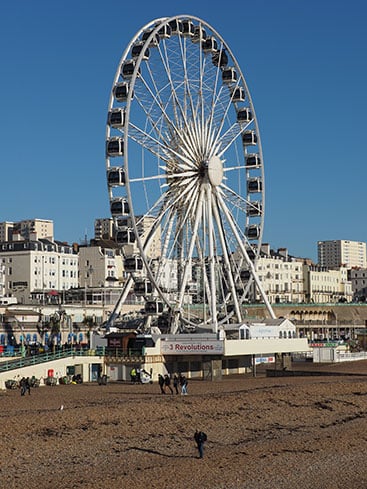 |  | |
| 40mm (80mm equivalent) | 150mm (300mm equivalent) | |
Olympus also offers a 1.4x teleconverter especially for the 40-150mm which extends the reach to an equivalent of 421mm with a maximum aperture of f4. I’ve provided three samples with it in my gallery, but here’s one as a preview. You can find the same shot taken without the teleconverter for comparison in my gallery and note the aperture selected delivered the best result in this instance.
| |||
Inside the 40-150mm f2.8 Pro there are 16 elements in 10 groups including ED, Super ED, EDA and HD elements. Essentially these technologies are designed to reduce internal light dispersion (ED stands for Extra-low dispersion, EDA is Extra-low Dispersion Aspheric and HD is High refractive index & Dispersion) and improve image quality and contrast.
The constant f2.8 aperture is maintained throughout the focal range, a very useful feature and not just for shooting in low light. The physical aperture diaphragm construction is composed of 9 blades which produce a circular shaped aperture that should result in pretty circular blob highlights for out of focus elements. At the other end of the range the minimum aperture is f22.
Many photographers will be interested to see how much they can blur the backgrounds of portraits or macro shots, so I have a number of examples here, lower on this page and on my sample images page. Below is a best-case scenario with the lens at 150mm f2.8 and the subject quite close, but even then the background isn’t hugely blurred compared to larger formats or brighter lenses. of course that may not be a bad thing – obliterating a background through a shallow depth of field can be fun, but comes at increased risk of missing the focus or only having part of your subject looking sharp. So while it may be harder to deliver very shallow depth of field effects with smaller formats like Micro four Thirds, it does come with the benefit of more forgiving focus.
| |||
I wanted to see how the 40-150mm compared to two popular prime lenses for portraits, the 45mm f1.8 and 75mm f1.8. I started with the 45mm f1.8 wide-open at f1.8, then took a second shot from the same position with the 40-150mm adjusted to deliver the same coverage at its maximum aperture of f2.8. Below you can see these side by side, with a crop from each taking a closer look at the rendering of the specular highlights. It’s clear even from the reduced image size that the 45mm f1.8 is delivering a much shallower depth of field with larger ‘bokeh blobs’. The crops also reveal the blobs to cleaner shapes, whereas the 40-150mm blobs show some visible onion-ringing. But the contrast is higher on the 40-150mm version.
Olympus 40-150mm portrait at 45mm f2.8 | Olympus 45mm f1.8 portrait at f1.8 | |
 |  | |
| 45mm f2.8 (90mm f5.6 equivalent in full-frame DOF terms) | 45mm f1.8 (90mm f3.6 equivalent in full-frame DOF terms) | |
 |  | |
| crop from image above | crop from image above | |
Next I switched to the 75mm f1.8, another popular portrait option for Micro Four Thirds and another of my favourite lenses. As before I framed the shot with the 75mm, then repeated with the 40-150mm from the same position, adjusted to deliver the same field of view. As you’d expect from the longer focal length, the background details are enlarged, including the bokeh blobs, and again the prime lens with its brighter focal ratio delivers a shallower depth of field. Similarly to the previous comparison, you’ll again see more evidence of onion-ringing from the 40-150mm compared to the 75mm due to its optical construction, although again the zoom delivers a higher contrast image when the aperture on both is wide-open.
Olympus 40-150mm portrait at 75mm f2.8 | Olympus 75mm f1.8 portrait at f1.8 | |
 |  | |
| 75mm f2.8 (150mm f5.6 equivalent in full-frame DOF terms) | 75mm f1.8 (150mm f3.6 equivalent in full-frame DOF terms) | |
 |  | |
| crop from image above | crop from image above | |
That’s the end of my zoom versus prime portrait examples, but not the end of the story, as the 40-150mm of course can extend much further. So here’s one final example, taken with the 40-150mm at 150mm f2.8, with a crop of the background alongside. The longer focal length has delivered an even tighter view of the background, allowing you to be very selective about what appears in it (so none of the walls or doors of the earlier shots). The bokeh blobs are also larger, although still not on the scale of the 75mm f1.8 example above. You’ll also notice much more squashed oval shapes towards the edges of the frame, and there’s still evidence of onion-ringing inside. I should also note framing a portrait at 300mm equivalent is not the easiest thing to achieve as you’ll be positioned quite far from your subject, but the example below does at least show the 40-150mm can deliver significant blurring if that’s the thing you desire.
Olympus 40-150mm portrait at 150mm f2.8 | Crop from image opposite | |
 |  | |
| 150mm f2.8 (300mm f5.6 equiv in full-frame DOF terms) | crop from image opposite | |
Apart from the maximum aperture another factor that affects depth of field is of course the distance to your subject. The 40-150mm f2.8 Pro boasts a closest focus distance of 70cm. That’s fairly close in practice and the distance remains the same regardless of the focal length – so at 150mm, it’s possible to fill the frame with fairly small subjects. Here’s a shot approaching the closest focusing distance, and lower on the page I have another at the closest distance.
| |||
Being able to shoot at close range also allows you to achieve some interesting depth of field effects. You can see above how the lens handles a close subject in daylight, but I wanted to have some fun after dark with specular highlights, so below are two shots taken at 40 and 150mm at the maximum f2.8 aperture and the closest focusing distance. The bokeh blobs are from Christmas lights hanging across the street.
Olympus 40-150mm close-up at 40mm f2.8 | Olympus 40-150mm close-up at 150mm f2.8 | |
 |  | |
| 40mm f2.8 (80 f5.6 equiv in full-frame DOF terms) | 150mm f2.8 (300 f5.6 equiv in full-frame DOF terms) | |
Another interesting impact of having an iris in a lens is the rendering of specular highlights at small apertures. As the aperture closes, diffraction causes these points of light to spread into starbursts, and it’s another area where one lens may deliver a better result than another. Below is an example I shot at night at 150mm f11 and there’s a clear starburst effect (as seen below right in the cropped area). It’s not the crispest I’ve seen by any means, but certainly usable.
Olympus 40-150mm starburst at 150mm f11 | Olympus 40-150mm starburst at 150mm f11 (crop) | |
 | 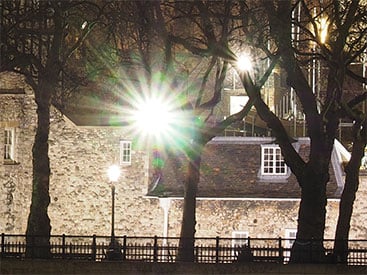 | |
| 150mm f11 full image | 150mm f11, cropped from lower right corner of image opposite | |
Olympus 40-150mm f2.8 Pro focusing
The 40-150mm f2.8 Pro is the first Olympus lens to feature dual VCM auto focus. The idea is that AF performance can be improved by separating the focusing mechanism into two lens groups controlled by individual linear drive voice coil motors. This and the absence of gears, claims Olympus, makes the focussing performance lightning fast and very smooth.
When Ken first tested the 40-150mm at the Cheltenham races, he had mixed experiences. For many shots, the 40-150mm locked-onto subjects quickly and without fuss, but for others it struggled, especially with faces in lower light conditions. As light levels reduced further, the lens suffered from more losses. To put it in perspective, it wasn’t bad, but equally it wasn’t the high hit rate we’ve come to enjoy and expect from top-end Micro Four Thirds gear. Was it an issue with the lens, or simply the longer than average focal length?
This was however a brief one-day test. Since then I’ve had a chance to shoot with the 40-150mm for a solid month (this is Gordon speaking!). During this time, Olympus released firmware version 2.2 for the OMD EM1 which, amongst other things, promised greater focusing accuracy with the 40-150mm lens.
This gave me a chance to perform before and after tests, and I’m pleased to report a visible improvement. With the older firmware, I experienced the mixed bag Ken initially described. Sometimes the combination performed brilliantly, but at other times lacked confidence and could hunt back and forth. After updating the EM1 firmware though, the 40-150mm felt a little faster and more confident overall. Most subjects snapped-into focus more easily than before in Single AF modes, and upon examination the subjects were sharp at 100%.
Inevitably as light levels or general contrast decreased, the lens / AF system found it harder to lock-on. At close range with the lens zoomed-in, you also have a shallower depth of field to deal with than most lenses in the Micro Four Thirds system, so it’s not surprising to experience more hunting when the going gets tough. But I would say there was a still visible improvement running the 2.2 firmware compared to before.
| |||
That said, it is important to say what the lens, or perhaps more fairly, the system can and can’t do. Mount the 40-150mm on an OMD EM1 and you’ll enjoy quick focusing on static subjects. This makes it great for portraits, landscapes or urban work. As I’ve said many times before though, continuous autofocus remains an Achilles’ Heel for Olympus and I know many people will be considering this lens for sports or action photography. You may enjoy more success than I did, but I failed to capture any convincing sequences of subjects approaching me at speed, whether birds, cyclists or kids running around. If the action is distant then you will get a few in focus, but if it approaches close enough to fill the frame you may become frustrated.
All Olympus Micro Four Thirds bodies employ built-in stabilisation with the most sophisticated five-axis system employed on the OMD EM1. To test the EM1’s built-in stabilisation with the M.Zuiko 40-150mm f2.8 Pro I took a series of shots in Shutter Priority mode at progressively slower shutter speeds with the stabilisation turned of and then enabled. As you can see from the 100 percent crops below, with stabilisation enabled you can shoot handheld with the 40-150mm f2.8 down to 1/20th, that’s nearly four stops of stabilisation. I actually managed to get a reasonably sharp result at 1/10, but not consistently and to be reasonably sure I’d draw the line at 1/20th.
Olympus OMD EM1 with 40-150mm f2.8 at 150mm stabilisation off/on | ||
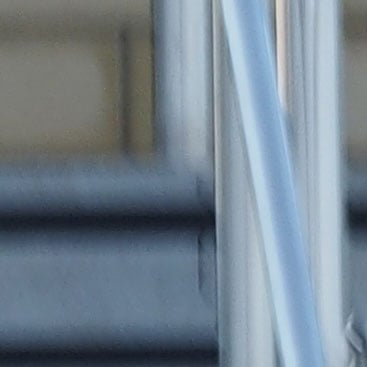 | 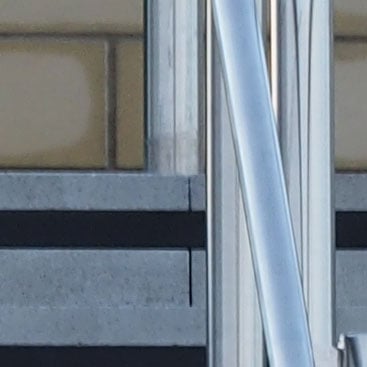 | |
| 100% crop 40-150mm at 150mm, 1/20, 200 ISO, IS off | 100% crop 40-150mm at 150mm, 1/20, 200 ISO, IS on | |
Olympus 40-150mm f2.8 Pro Image quality
For the next section of my review I’ve picked out a selection of images I shot over the course of the day at Cheltenham race course. All shots are JPEGs straight out of the cameras with no modification – you can download any of them via Flickr by clicking the desired image. On the results page you’ll see processed RAW files, and on the gallery page you’ll see a selection of additional images shot by Gordon.
| |||
| |||
This first image above was taken with the 40-150mm f2.8 at its maximum telephoto focal length and with the aperture wide open at f2.8. The shooting mode was set to continuous low with the auto focus set to continuous. I selected the central AF point and tried to keep the rider in the red and blue silks in the center of the frame. This is the eighth frame of a ten-frame sequence, exactly half of which (the first frame and the final four) were sharp on the subject in the AF frame.
| |||
| |||
I’ve included this second image really just to show the shallowness of the depth of field with a reasonably close subject and the pleasant bokeh produced by the 40-150mm’s circular aperture diaphragm. This time the AF has nailed it with good sharp detail in the face.
| |||
| |||
When it gets it right the 40-150mm f2.8 produces stunningly sharp detail. This time set to S-AF mode with the light fading, but still bright enough to shoot wide open at 200 ISO with the stabilisation enabled.
| |||
| |||
The 40-150mm f2.8 has a closest focus distance of 70cm. That’s constant regardless of the focal length so you can get close in at 150mm to produce very shallow depth of field shots.
| ||||
| ||||
Finally, here’s a more conventional portrait shot taken under room lighting at 80mm. At this focal length even at f2.8 the 40-150mm doesn’t quite throw the background out far enough to avoid it being a distraction. If you anticipate shooting a lot of portraits at around 40mm and want a shallower depth of field, you’ll be better off with the Olympus 45mm f1.8 prime.
You can check out a more detailed look at the sharpness at different apertures in my Olympus 40-150mm f2.8 quality section, browse these and more samples in my Olympus 40-150mm f2.8 sample images page, or head over to my verdict.
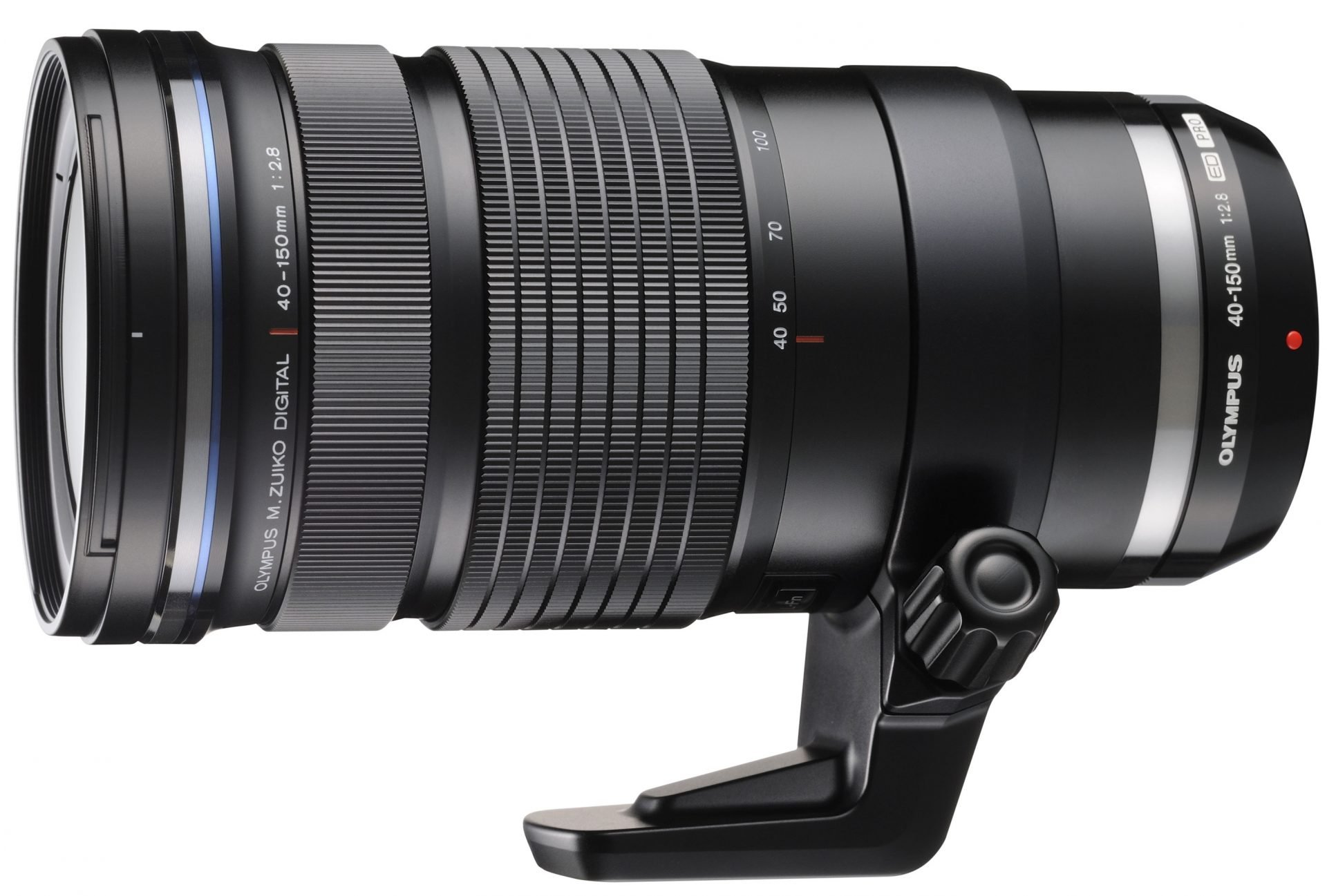
 The Olympus 40-150mm f2.8 Pro is a high-end telephoto zoom with a constant f2.8 focal ratio. With equivalent coverage of 80-300mm, it's ideal for portraiture and street photography, along with nearby sports and wildlife. It handles quickly, shrugs-off inclement weather, and delivers very sharp and high contrast images right into the corners even at the maximum aperture. The focal range is also comfortably longer than the rival Lumix 35-100mm f2.8, although it is physically larger too. Personally speaking I prefer to shoot with brighter primes for a shallower depth of field, but if you're happy with the blurring capabilities of the Olympus 40-150mm, it's a powerful lens to have in your collection.
The Olympus 40-150mm f2.8 Pro is a high-end telephoto zoom with a constant f2.8 focal ratio. With equivalent coverage of 80-300mm, it's ideal for portraiture and street photography, along with nearby sports and wildlife. It handles quickly, shrugs-off inclement weather, and delivers very sharp and high contrast images right into the corners even at the maximum aperture. The focal range is also comfortably longer than the rival Lumix 35-100mm f2.8, although it is physically larger too. Personally speaking I prefer to shoot with brighter primes for a shallower depth of field, but if you're happy with the blurring capabilities of the Olympus 40-150mm, it's a powerful lens to have in your collection.